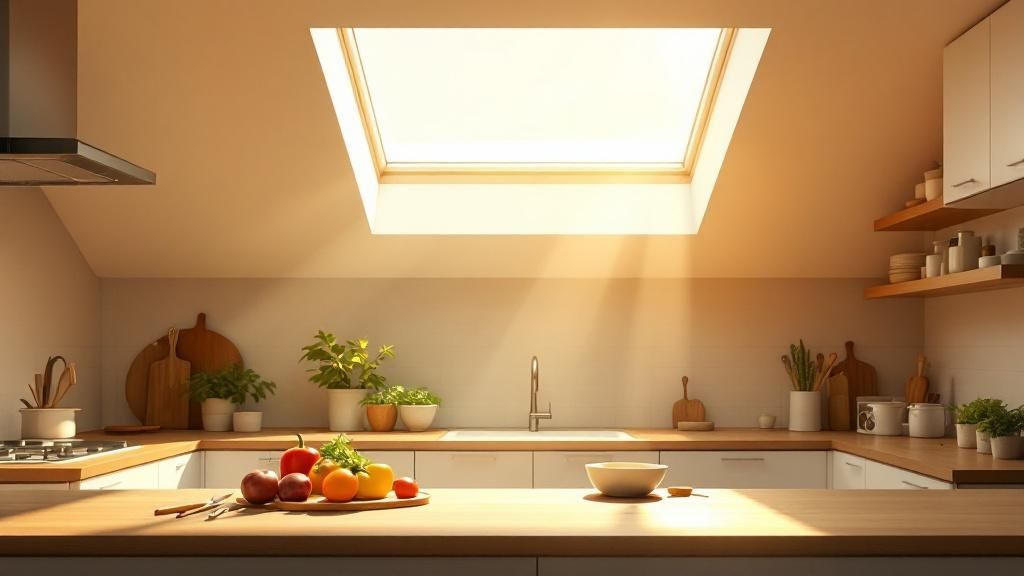
Why Smart Homeowners Choose Kitchen Skylights
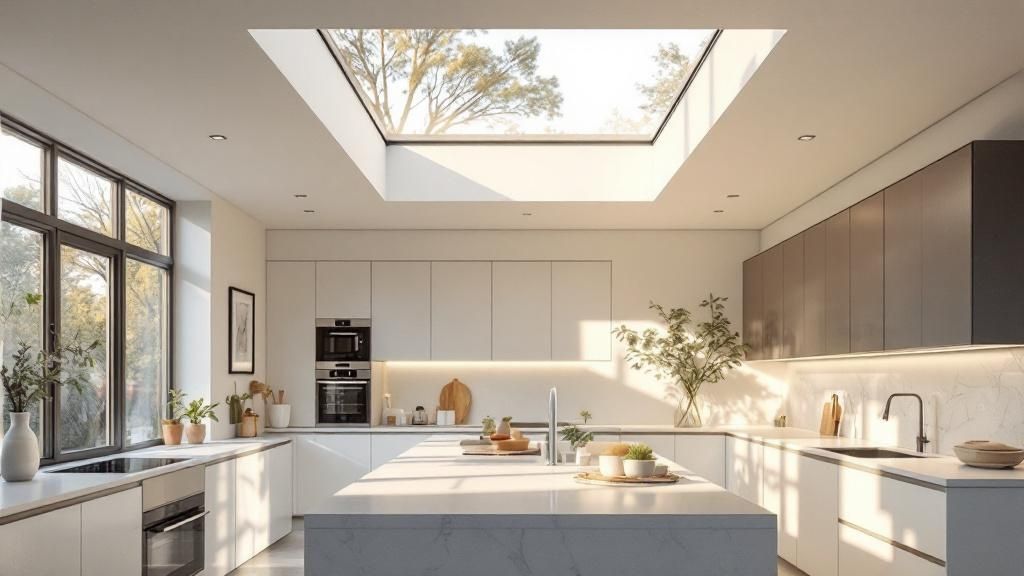
Imagine prepping dinner in a dimly lit kitchen, squinting to see what you’re doing. Now, picture that same scene bathed in the warm, natural light from a skylight. It’s a simple change, but the impact is huge. It transforms the entire feel of the space, and it’s a big reason why more and more Australian homeowners are bringing skylights into their kitchens. They’re turning functional cooking spaces into bright, inviting heart-of-the-home gathering spots.
The Psychology of Natural Light
Light does more than just help us see. It affects how we feel. Studies show a strong connection between natural light and a better mood. Think about how much nicer it is to enjoy your morning coffee in a sun-drenched room compared to a dark one. That sense of openness and connection to the outdoors can truly elevate your everyday kitchen experience.
Solving Common Kitchen Problems
Besides the emotional benefits, skylights tackle practical kitchen issues. Many Australian kitchens, especially older ones, are short on natural light. This can make tasks like chopping vegetables tricky and create a cramped feeling. A well-placed skylight can instantly solve these problems, making the room feel bigger and brighter. Plus, they can help with dampness and stuffiness, a real bonus in Australia’s humid climate.
The growing popularity of skylights in Australian kitchens reflects a global shift toward sustainable building. The worldwide skylight market is booming, expected to hit USD 4.44 billion by 2028. This demand is driven by a desire for eco-friendly building practices, a trend that’s definitely influencing the Australian market. Discover more insights into the skylight market. This widespread adoption really shows how much people value natural light.
Beyond the Basics: Unexpected Benefits
Many people discover surprising perks after installing a kitchen skylight. Better food photos for social media are a common one, thanks to that gorgeous natural light. Others find that the brighter space is more inviting for guests. Planning a kitchen skylight can affect your overall remodeling budget. Here’s some information about kitchen remodel. These unexpected pluses add to the overall satisfaction homeowners feel about their skylight investment. And, that extra light can actually increase your home’s value, a tangible return on investment that can pay off later.
Finally, think about the energy savings. Relying less on artificial lights, especially during the day, can noticeably lower your electric bills. This financial benefit, combined with the aesthetic and mood-boosting advantages, makes a strong argument for why smart homeowners are choosing to brighten their kitchens with skylights.
Fixed vs. Opening Skylights: Finding Your Kitchen’s Match
Choosing between fixed and opening skylights for your kitchen can feel a bit like choosing between a regular window and a garden window. Both let in light, but one offers that extra breath of fresh air and connection to the outdoors. Let’s explore the nuances of fixed and opening skylights and how they can transform your kitchen experience. Fixed skylights are your steadfast companions, dependably providing natural light while maintaining excellent insulation and weather protection. If your primary goal is maximizing light without the added expense or upkeep of moving parts, fixed skylights are a fantastic option. Opening skylights, on the other hand, offer the bonus of ventilation alongside natural light, perfect for whisking away cooking odors or steam.
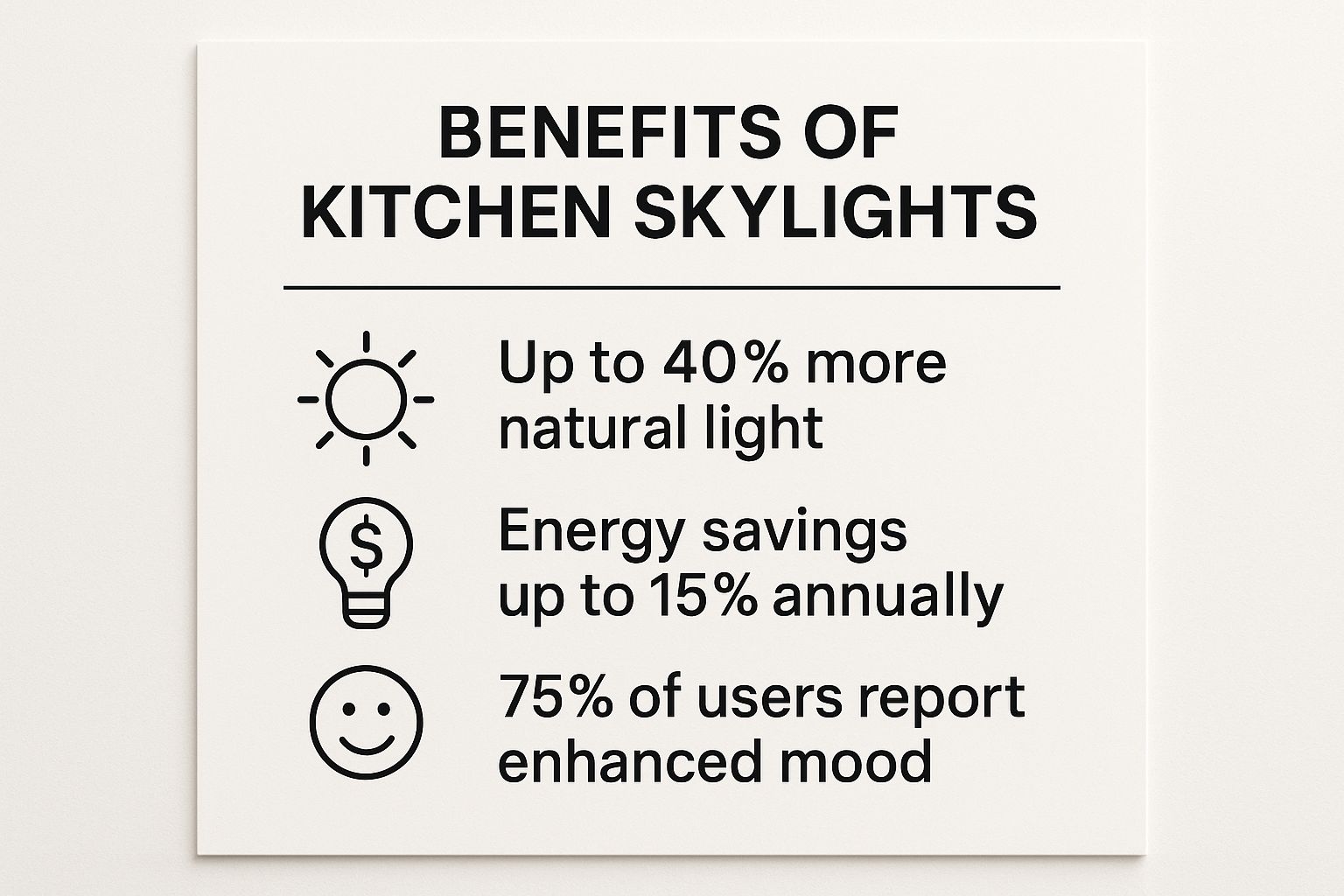
This infographic showcases some compelling reasons to consider a skylight for your kitchen, including increased natural light, energy savings, and a noticeable improvement in mood. Kitchen skylights go beyond mere aesthetics, brightening your space with up to 40% more natural light and potentially leading to annual energy savings of up to 15%. The reported 75% boost in user mood speaks volumes about the positive impact natural light can have on well-being.
Considering Your Kitchen’s Needs
Take a moment to think about your current kitchen layout and cooking habits. Do you often find yourself struggling with persistent cooking smells? Does condensation become a nuisance on your windows during colder months? If so, the ventilation provided by an opening skylight might be just what you need. If your kitchen already has good ventilation and your primary aim is simply more natural light, a fixed skylight could be the ideal solution. You can delve deeper into different skylight options at Vividskylights.com.au. Check out our comprehensive guide on types of skylights.
Real-World Scenarios: Fixed vs. Opening
Picture this: you’re preparing a flavorful stir-fry. With a fixed skylight, you’d rely on your range hood to tackle the cooking fumes. But with an opening skylight, you can quickly ventilate the air, leaving your kitchen fresh and inviting. This simple example highlights the core difference in functionality.
Let’s consider another scenario. If you live in a humid climate, the ventilation from an opening skylight can drastically reduce moisture buildup, preventing mold and mildew. Think of it as a breath of fresh air for your kitchen, helping to maintain a healthy and comfortable environment.
Additionally, the location of your kitchen plays a role. If your kitchen is exposed to strong winds or heavy rain, a fixed skylight offers peace of mind, eliminating the worry of closing it during inclement weather. This makes a fixed skylight a lower-maintenance option in regions with challenging weather conditions. Conversely, if you relish the feeling of fresh air circulating through your kitchen, especially during pleasant weather, an opening skylight allows you to seamlessly connect with the outdoors.
To help you visualize the key differences, let’s look at a comparison table:
Fixed vs Opening Skylights for Kitchen Applications
A detailed comparison of features, benefits, and drawbacks of each skylight type specifically for kitchen use
| Feature | Fixed Skylights | Opening Skylights | Best for Kitchen Use |
|---|---|---|---|
| Ventilation | No | Yes | Depends on kitchen needs |
| Natural Light | Excellent | Excellent | Both |
| Maintenance | Low | Moderate (due to moving parts) | Depends on homeowner preference |
| Cost | Lower | Higher | Depends on budget |
| Weather Protection | Excellent | Good (requires proper sealing) | Depends on climate |
| Suitable for… | Kitchens with existing good ventilation, maximizing natural light is priority | Kitchens requiring extra ventilation, managing cooking odors and humidity | Consider your individual needs and priorities |
As you can see, the “best” choice truly depends on your specific kitchen environment, cooking habits, and overall preferences. While both fixed and opening skylights offer the beauty of natural light, opening skylights provide the added benefit of ventilation, which can be invaluable in certain kitchen settings.
Sizing and Placement: Getting It Right The First Time
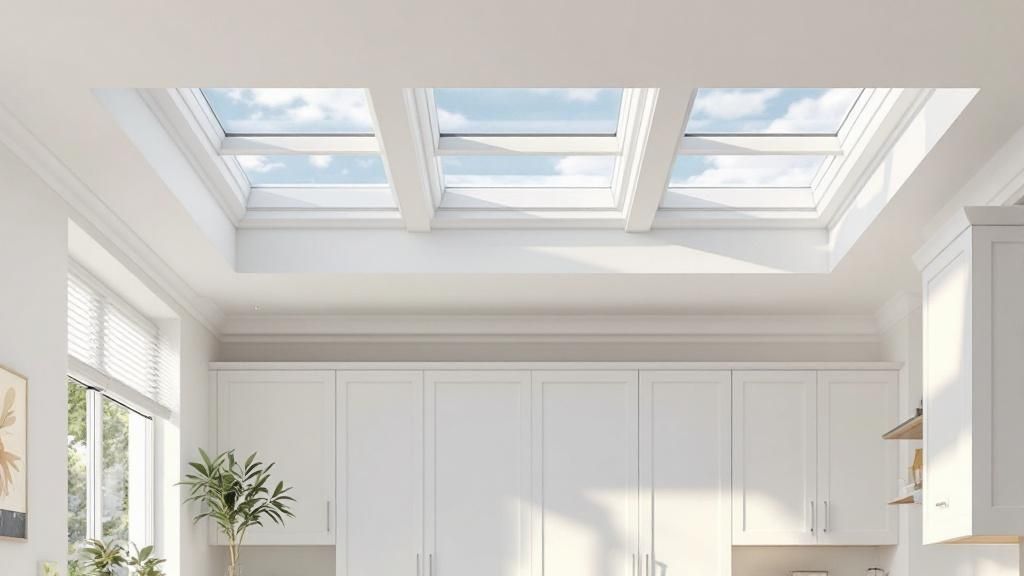
Picking the right size and placement for your kitchen skylight is a crucial first step. Think of it like choosing the perfect window: too small and it barely makes a difference, too big and it can feel overwhelming. Planning ahead here avoids costly regrets down the line. Let’s explore how to strike the perfect balance.
Skylight Sizing: Avoiding the Greenhouse Effect
Many people assume bigger is always better with skylights. But an oversized skylight in a kitchen can create an unwelcome greenhouse effect, especially during hot summers. Imagine trying to cook in a sauna! Not only is this uncomfortable, but it can also send your energy bills soaring as you try to cool the space. Plus, excessive direct sunlight can cause harsh glare, making it hard to prep food and potentially damaging sensitive ingredients.
Imagine a small galley kitchen with a huge skylight. Instead of feeling bright and airy, the intense sunlight could make the space feel cramped and stifling. On the other hand, a tiny skylight in a large, open-plan kitchen might not provide enough natural light to be noticeable. That’s why considering your kitchen’s size and layout is so important.
Furthermore, in Australia, incorporating skylights into kitchens reflects a larger architectural movement towards natural light and ventilation. This is particularly true in sunny regions where skylights can drastically reduce the need for artificial lighting. Solar-powered skylights are also becoming more popular for their energy efficiency and ventilation capabilities.
Strategic Placement: Enhancing Your Workflow
Placement is just as important as size. A beautifully installed skylight in the wrong spot is like a spotlight shining on an empty stage – plenty of light, but not where you need it.
Think about your daily kitchen routine. Where do you spend most of your time? Is there a specific prep area where good lighting is essential? Or perhaps you want to create a dramatic lighting effect over a kitchen island for entertaining guests?
Illuminating Your Kitchen’s Daily Rhythms
Consider the sun’s path throughout the day. A skylight positioned to catch the morning sun can turn your early coffee routine into a sun-drenched delight. A west-facing skylight, however, might create stunning afternoon light but also bring unwanted heat during summer evenings. By thinking about the sun’s movement, you can position your skylight to maximize its benefits all day long.
Positioning a skylight directly over your main workspace can illuminate your chopping board and countertops, improving visibility and reducing eye strain. Imagine prepping intricate dishes with the clarity of natural light rather than harsh, artificial lighting. This simple placement choice can truly elevate your cooking experience.
By carefully considering both size and placement, you can ensure your skylight not only looks great, but also enhances the functionality and overall feel of your kitchen. A well-placed and appropriately sized skylight creates the perfect balance of natural light, ventilation, and aesthetic appeal, turning your cooking space into a bright and airy haven.
Installation Reality Check: What Actually Happens
Let’s be honest: installing a skylight in your kitchen isn’t a quick weekend DIY project. It’s more like a carefully orchestrated mini-renovation. You’ll need skilled professionals, a good dose of patience, and a realistic understanding of the potential disruptions to your daily routine.
From Assessment to Completion: A Step-by-Step Look
Before any work begins, a thorough structural assessment of your roof is crucial. Think of it like a doctor giving you a check-up. This assessment involves examining your roof’s framing, insulation, and any existing electrical or plumbing that runs through the area. This crucial first step determines if your skylight dreams are structurally feasible and identifies any potential challenges upfront.
Installation timelines vary based on several factors, including the complexity of your roof, the size of the skylight, and accessibility. Kitchens, in particular, can present unique challenges. Installers often have to work around existing cabinetry, potentially reroute plumbing or electrical lines, and seamlessly integrate the skylight with your ventilation system. These factors can add time and complexity to the project.
Common Surprises and How to Avoid Them
Even experienced installers encounter unexpected issues during kitchen skylight installations. Think of it like renovating an old house – you never know what you’ll find behind the walls. Unforeseen structural problems, hidden wiring, or outdated plumbing can lead to project delays and require budget adjustments. Open and honest communication with your contractor is the best way to address these surprises effectively and minimize their impact.
Permit requirements can differ significantly between states and even local councils. Some projects might only need a basic building permit, while others could require more complex approvals related to structural changes or energy efficiency regulations. Understanding these requirements is essential for a smooth and legally sound installation.
Permits and Approvals: Navigating the Red Tape
In Australia, building permits are generally not required for skylight installations. The specific requirements vary by state and local council, and some regions have stricter rules regarding energy efficiency or structural modifications. Working with a reputable installer familiar with local building codes can simplify this process and ensure everything is done by the book.
Preparing Your Kitchen and Home
Once the installation date is confirmed, it’s time to prepare your kitchen and home. Protecting appliances and countertops from dust and debris is paramount. You’ll also need to plan for temporary cooking arrangements. Imagine your kitchen as a temporary construction zone. This might involve setting up a temporary cooking area in another room or planning meals that don’t require extensive kitchen use. Having a clear plan minimizes disruption and makes the process smoother.
Think of it like preparing for a mini kitchen remodel. You’d likely cover surfaces, move appliances, and possibly clear out some cabinets. Similar preparations are necessary for a skylight installation.
By understanding the realities of installation, anticipating potential challenges, and planning accordingly, you can ensure a smooth and successful skylight project. Approaching these discussions with your contractor with realistic expectations and the right questions will lead to better outcomes and a more enjoyable renovation experience. This allows you to discuss potential issues proactively, creating a collaborative atmosphere and minimizing surprises during the installation.
Smart Skylights: Technology That Actually Makes Sense
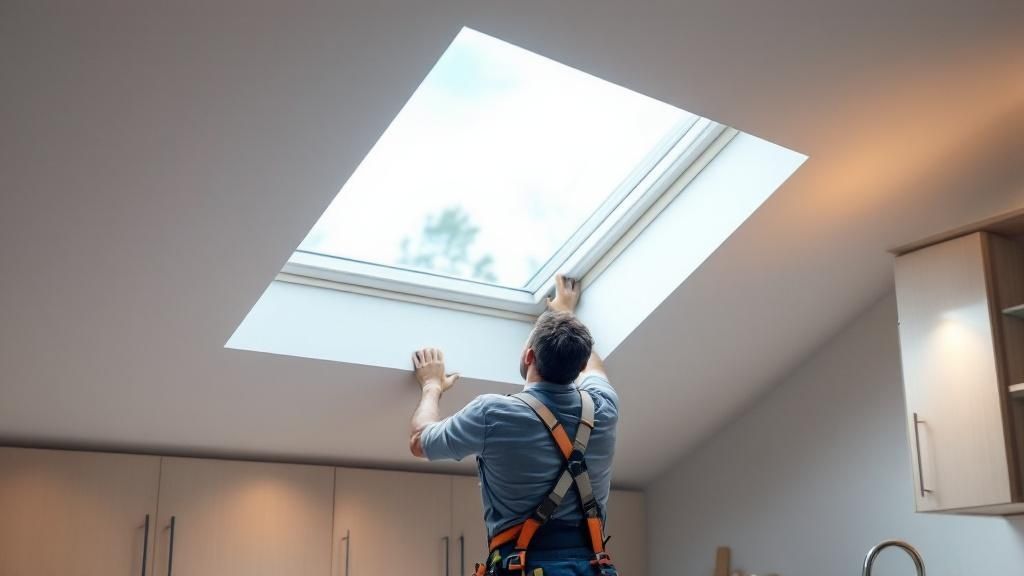
Kitchen skylights aren’t just static panes of glass anymore. They’re evolving into intelligent features that adapt to your cooking needs. But let’s be honest, not all “smart” features are actually smart. Some are truly useful, while others feel more like a gimmick. Let’s explore the innovations that truly enhance your kitchen versus those that just add complexity.
Automation That Simplifies Your Life
Picture this: you’re simmering a delicious Bolognese, and the kitchen fills with steam. An automated opening system senses the humidity and heat, venting the moisture without you needing to adjust anything. It’s like having a silent helper who keeps your kitchen comfortable while you focus on cooking.
Solar-powered options offer this control without the need for wiring, making them both convenient and eco-friendly. And if you want the ultimate in control, remote-controlled systems let you adjust your skylight from anywhere in the room – whether you’re at the stove or checking the oven.
Weather Protection and Peace of Mind
Ever left the house only to be struck by a sudden downpour? Rain sensors are a lifesaver in these situations. They automatically close your skylight at the first sign of rain, preventing water damage even when you’re not home. This offers incredible peace of mind, especially in unpredictable climates.
The skylight market is growing in places like Europe due to increased construction and a focus on sustainable building. With Australia’s increasing interest in energy-efficient solutions, similar trends are likely emerging here. Features like automatic glare control and energy-efficient glazing are becoming more attractive to homeowners. This suggests a potential rise in skylight use in Australian kitchens as part of a broader move towards sustainable living. Find out more about skylight market trends. Installing a skylight can be more straightforward than you might think, although professional installation is often the best route. Explore this easy skylight installation resource for further information.
Beyond the Gimmick: Features That Truly Matter
Smart technology should simplify your life, not complicate it. Advanced glazing technologies can filter out harsh afternoon sun while maximizing the soft glow of morning light, creating a comfortable kitchen atmosphere all day long. Some smart controls even learn your preferences over time, adjusting light and ventilation automatically based on your past behavior.
Choosing the Right Technology for Your Kitchen
The aim isn’t to fill your kitchen with gadgets. It’s about selecting the features that genuinely improve your cooking experience. Think about your daily routines and what frustrates you most in your current kitchen. Do you struggle with ventilation? Is glare an issue during food prep?
By focusing on solving actual problems, you choose smart features that add real value, not just novelty. Consider the long-term benefits of each feature. Will it truly enhance your cooking, or will it become another rarely used gadget? Prioritizing practicality and ease of use ensures a smart investment that you’ll appreciate for years to come.
Keeping Your Skylight Investment Bright
Let’s talk skylight maintenance – it’s not as daunting as you might think! It’s less about strict schedules and more about understanding your specific needs. Just like your garden needs different care in Darwin compared to Hobart, your skylight’s maintenance depends on factors like your cooking habits, the local climate, and even nearby trees. A skylight over a busy stovetop in a humid climate will naturally need more attention than one over a quiet prep area in a drier region.
Realistic Maintenance: What Truly Matters
These days, skylights are getting smarter, with features like automatic rain sensors and even built-in blinds. But when it comes to maintenance, some tasks are truly essential, while others are less critical. Chatting with homeowners who’ve had skylights for years reveals a surprising truth: regular exterior cleaning is crucial, especially in dusty or coastal areas, to keep that sunlight streaming in. But internal cleaning? That might only be a once-in-a-while task depending on how much cooking you do. Think of it like cleaning your kitchen windows – regular light cleaning prevents the need for heavy scrubbing later on. You might also be interested in learning more about skylight insulation.
Cleaning Schedules and Effective Products
Keeping your skylight sparkling doesn’t mean daily scrubbing. A realistic cleaning schedule, perhaps a quick wipe every few weeks and a more thorough clean twice a year, prevents grime build-up without taking over your life. Just like you wouldn’t use harsh chemicals on a non-stick pan, you need to be mindful of the cleaning products you use on your skylight. Harsh chemicals can damage special coatings, so stick to gentle cleaners and soft cloths to protect your investment and keep your skylight looking its best.
DIY vs. Professional: Knowing When to Call for Help
Some skylight tasks are easy DIY fixes, like cleaning the glass or replacing a damaged flyscreen. But other issues, like leaks, electrical problems, or structural repairs, are best left to the experts. Think of it like maintaining your car: you can probably handle an oil change, but you’d take it to a mechanic for more complex issues. Knowing when to call a professional for your skylight can save you time and money in the long run. Watch out for signs like persistent leaks, condensation between glass panes, or difficulty opening and closing – these are red flags that call for professional help.
Kitchen-Specific Maintenance Considerations
Kitchens are unique environments, and your skylight needs specific care in this setting. Condensation, especially in cooler climates, is common and can lead to mold if left unchecked. Good ventilation and occasional wiping can prevent this. Similarly, cooking residue can build up over time, especially near the stovetop. Regular cleaning with the right products will stop this from becoming a stubborn problem. By understanding these kitchen-specific challenges, you can create a maintenance plan that works for you and your home.
To help you stay organized, here’s a handy table summarizing key maintenance tasks:
Kitchen Skylight Maintenance Schedule and Costs
A practical guide showing recommended maintenance tasks, frequency, and typical costs for kitchen skylights.
| Maintenance Task | Frequency | DIY Cost | Professional Cost | Importance Level |
|---|---|---|---|---|
| Visual Inspection (check for leaks, cracks, etc.) | Quarterly | $0 | $50-$150 (as part of a general inspection) | Medium |
| Clean Exterior Glass | Quarterly | $0 (water and a soft cloth) | $50-$100 per skylight | Medium |
| Clean Interior Glass | Bi-annually or as needed | $0 (water and a soft cloth) | $50-$100 per skylight | Medium |
| Check and Clean Seals | Annually | $0 (visual inspection) | $100-$200 (including resealing if needed) | High |
| Clean and lubricate opening mechanisms (if applicable) | Annually | $10-$20 (lubricant) | $75-$150 | Medium |
| Professional Inspection | Every 3-5 years | N/A | $150-$300 | Medium |
This table gives you a starting point for your own maintenance schedule. Remember, these are just guidelines, and you may need to adjust based on your individual circumstances. Staying on top of these simple tasks will help keep your kitchen skylight bright and beautiful for years to come.
Your Skylight Investment: Real Costs and Returns
Let’s talk money. Just like any home improvement project, installing a kitchen skylight involves more than the initial sticker price. Think of it like planning a kitchen renovation – the cabinets and appliances are just the beginning. You also need to factor in countertops, flooring, and installation. Similarly, understanding the full cost of a skylight involves looking beyond the price of the unit itself.
Understanding the Price Range
So, what’s the damage? In Australia, kitchen skylights can range from a few hundred dollars for a basic fixed skylight to several thousand for a top-of-the-line, automated, opening skylight with all the extras. A standard fixed skylight might cost somewhere between $720 and $1,590. If you’re looking at a larger, electric opening skylight, you’re looking at $1,630 to $5,000 or more, depending on the size and features. Remember, these prices typically cover the skylight unit itself; installation is an additional cost. You can get a clearer picture of installation costs in our dedicated guide on skylight installation cost.
Factors Affecting Your Final Bill
Several things can influence the final price tag of your skylight. The type of skylight is a big one. Fixed skylights tend to be more budget-friendly than opening skylights due to their simpler mechanics. Size also matters – a larger skylight naturally requires more materials and labor, bumping up the price. The complexity of the installation plays a role, too. Tricky rooflines or difficult access points can add to the labor costs. And finally, any additional features, like automated openers, blinds, or special glazing, will impact the overall cost.
Value vs. Price: Making Smart Choices
Not all upgrades are created equal. Some, like automated openers or rain sensors, offer genuine convenience and protection. Others might be more about aesthetics. Think about the actual benefits of each upgrade compared to its cost. For example, energy-efficient glazing might seem pricey upfront but could save you money on your energy bills over time.
Beyond the Initial Investment: Long-Term Costs and Returns
It’s important to think long-term. Energy savings are a real plus, with some homeowners reporting significant reductions in their electricity bills – sometimes as much as 10-15% annually. Increased home value is another potential benefit, as natural light is a highly desirable feature in the Australian property market.
But don’t forget the ongoing costs. Things like cleaning supplies, occasional professional maintenance, and potential repairs should be part of your budget. These costs are usually small but still worth considering.
Beyond the dollars and cents, many homeowners experience intangible benefits that are hard to put a price on. Think about the improved mood while cooking, better visibility for food prep, and a more inviting kitchen for entertaining. These lifestyle improvements contribute to the overall value, creating a kitchen you genuinely love.
Ready to bring the sunshine in? Check out the range of high-quality skylights at Vivid Skylights and discover how we can brighten your home.
